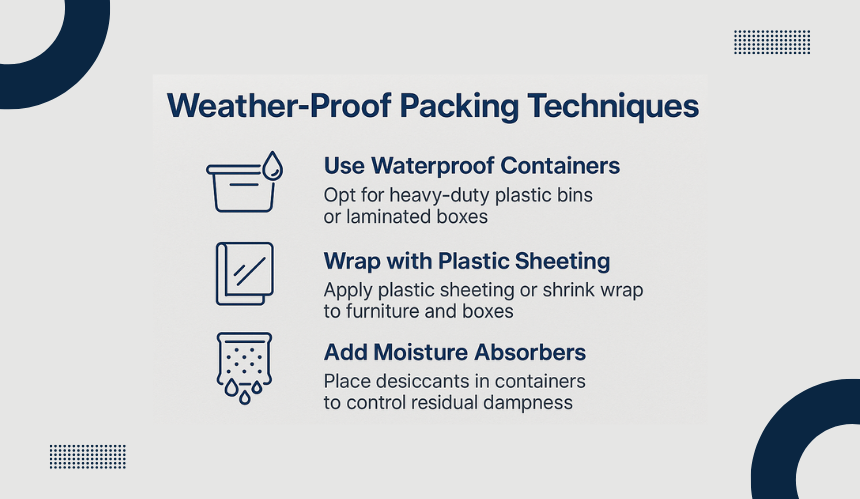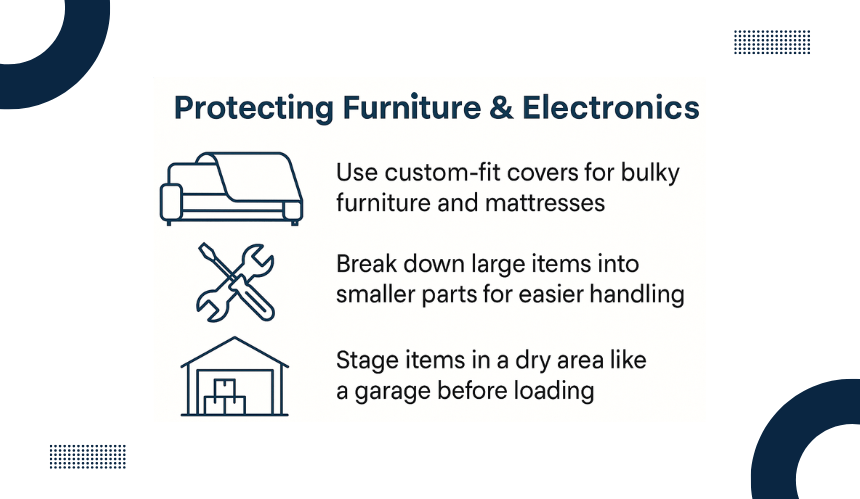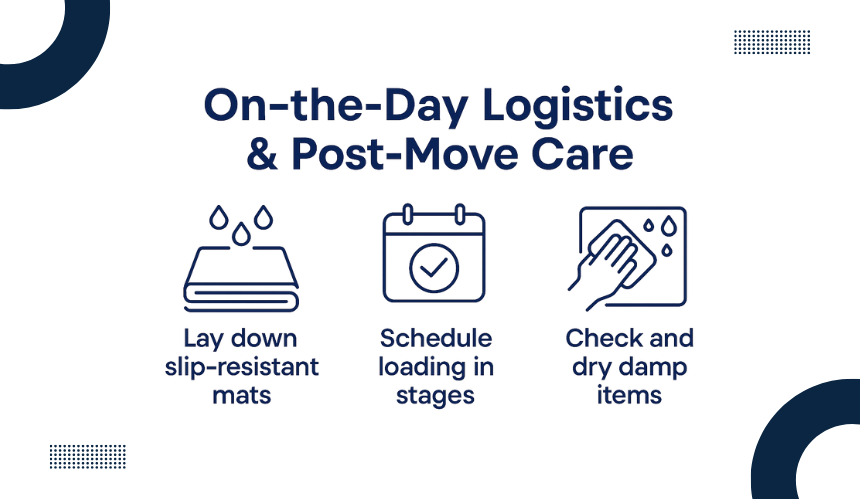
- Phil
- September 12, 2025
Moving During Rain or Snow: How to Weather-Proof Your Belongings
Moving day can be stressful even under clear skies, but rain or snow introduces challenges that go beyond simple inconvenience. Moisture can damage furniture, electronics, and boxes, while icy or slippery conditions increase the risk of accidents during loading and unloading.
The easiest way to weather-proof your belongings during a move is to pack items in waterproof or sealed containers, wrap furniture and electronics with heavy-duty plastic covers or shrink wrap, and stage loading or unloading under covered areas to keep everything dry.
This article will guide you through practical steps to weather-proof your belongings so they stay safe and dry during transit to help you make your move stress-free.
Understanding the Risks of Moving in Rain or Snow

Even a carefully planned move can quickly go off track when bad weather enters the picture. Rain, sleet, or snow doesn’t just make moving day unpleasant; it exposes belongings and people to very real hazards.
How Rain and Snow Put Your Belongings During a Move at Risk?
Moisture can seep into cardboard boxes, weaken their structure, and damage the contents inside. Upholstered furniture, wooden pieces, and electronics are especially vulnerable to water damage. Snow brings its own challenges: melting ice can cause prolonged dampness, leading to warping, staining, or even mold if items aren’t dried quickly.
Safety and Logistical Hazards During a Wet or Snowy Move?
Rain-slicked walkways, icy stairs, and wet truck ramps increase the risk of slips, falls, and dropped items. Weather delays can also disrupt schedules, forcing movers to rush or cut corners. These conditions can raise costs and stress levels if you’re not prepared with extra time or help.
Pre-Move Planning Strategies to Minimize Weather Impact During a Move

Before a single box is packed, careful planning can make the difference between a chaotic and a seamless move in wet or snowy conditions.
By anticipating potential weather challenges and following the strategies explained below, you can reduce damage risks, delays, and stress on moving day.
1. Monitor Weather Forecasts and Build Flexible Timelines
Check local and extended forecasts as soon as you set a moving date. If a major storm appears likely, coordinate with your moving company about backup dates or staggered loading times. Having a flexible schedule reduces the chance of moving during the worst conditions and allows you to prepare protective measures in advance.
2. Coordinate with Movers on Weather Contingencies
Not all moving companies handle bad weather the same way. Ask upfront about their policies for rain or snow, what protective materials they bring, and whether they offer rescheduling without penalties. This ensures you’re not caught off guard if conditions turn severe.
3. Arrange Covered Pathways and Protective Staging Areas
Set up tarps, temporary canopies, or garage spaces where items can be staged before going onto the truck. This creates a buffer zone between indoor and outdoor environments, so boxes and furniture spend minimal time exposed to the elements.
Weather-Proof Packing Materials and Techniques

Choosing the right materials and packing methods sets the foundation for a successful move in wet or snowy weather. This stage is about proactively building a barrier between your items and the elements. Follow the techniques explained below to keep your belongings protected from moisture and damage throughout the move.
1. Prioritize Non-Absorbent Packing Options
Select heavy-duty plastic bins or laminated cardboard boxes that repel moisture. Use strong, waterproof tape to seal edges and seams so water cannot seep in during loading or transit.
Opt for clear bins where possible so you can easily identify contents without opening lids and exposing them to the weather.
2. Wrap Belongings in Protective Layers
Apply thick plastic sheeting or shrink wrap to furniture and sensitive items before boxing them. This layer locks out moisture and provides an additional shield against dirt or slush. Secure these wraps tightly with straps or stretch film so they won’t loosen or tear while items are being moved.
3. Add Desiccants for Extra Moisture Control
Place silica gel packets or other desiccants in containers holding fabrics, books, or electronics accessories. This precaution absorbs any residual dampness that may occur during travel.
For longer moves or climate changes, refresh desiccants halfway through to keep their absorption power at its peak.
4. Leverage the Expertise of a Moving Partner
If handling all this preparation feels overwhelming, hiring a professional moving company can be a smart choice. Experienced movers often supply waterproof packing materials, load items efficiently to minimize exposure, and bring additional coverings for doorways and walkways.
How to Protect Large Items and Furniture from Moisture Damage While Moving

Bulky furniture pieces and oversized items are the most difficult to shield in harsh conditions. This section focuses on strategies to keep them safe without duplicating packing tips already covered above. Pro tips to protect large items and furniture during a move are explained below:
1. Employ Custom-Fit Covers for Oversized Items
Use specially designed mattress bags, couch protectors, or padded weather-resistant furniture wraps. These covers fit tightly, preventing slippage and full exposure to rain or snow.
2. Break Down Components for Easier Handling
Disassemble tables, shelving units, or bed frames into manageable parts. Smaller pieces are easier to maneuver through narrow doorways and can be wrapped separately for stronger protection.
3. Establish a Clean Indoor Loading Zone
Reserve a dry area like a garage, lobby, or covered porch to stage large items before they leave the house. This reduces the time they spend outdoors and gives movers room to maneuver safely.
How to Safeguard Electronics, Documents, and Valuables While Moving in Rainy Weather
Sensitive, high-value belongings call for their own level of attention. These items are not only vulnerable to moisture but also to data loss or theft if mishandled.
1. Use Specialized Containers for Electronics
Pack computers, gaming consoles, and audio equipment in padded, waterproof cases designed for electronics. Include shock-absorbing materials inside to protect against bumps during transport. Label each case as “fragile” and “keep upright” so movers handle them correctly and avoid stacking heavy items on top.
2. Protect Critical Documents with Waterproof Sleeves
Place passports, certificates, contracts, and other essential papers in sealed, waterproof sleeves or zipper pouches. This guards against spills and condensation inside moving containers. Keep a digital copy of these documents on a secure cloud service or an encrypted USB drive as an instant backup in case of unforeseen loss.
3. Handle Irreplaceable Valuables Personally
Carry jewelry, heirlooms, or confidential files with you rather than loading them on the moving truck. This ensures full control and zero exposure to unpredictable conditions. Store these items in a small lockable travel bag or case to keep them organized and discreet while in transit.
On-the-Day Logistics: Moving Safely in Rain or Snow

After thorough planning and preparation, execution on moving day makes all the difference. These tips address the conditions you’ll face in real time. Follow the instructions below to keep your moving day smooth and stress-free.
1. Set Up Weather Barriers Along Walkways
Lay down slip-resistant mats or temporary runners from the door to the truck to create a safe, dry path. This protects both movers and your belongings from mud, ice, or puddles.
2. Schedule Loading in Stages to Limit Exposure
Load items in batches rather than leaving everything outside at once. This approach keeps most belongings indoors until the truck is ready, reducing their time in wet or snowy conditions.
3. Use Protective Entryway Coverings
Hang plastic sheeting or temporary door covers at entry points to block rain, snow, and drafts from entering your home while movers pass through. This keeps floors dry, prevents slippery conditions indoors, and maintains a safer work environment.
Post-Move Drying and Damage Control After Moving in Rainy Weather
Even with careful preparation, some belongings may still get damp during transit. Taking swift action once everything is unloaded can prevent minor moisture issues from becoming permanent damage. This stage focuses on immediate inspection, quick-drying techniques, and recovery measures.
1. Inspect All Items Immediately Upon Arrival
As soon as boxes and furniture are off the truck, check them for visible moisture or damage before unpacking. Prioritize inspecting vulnerable items such as electronics, documents, and wood furniture. Create a simple checklist and mark each item as “dry” or “wet” so nothing gets overlooked during the rush of unpacking.
2. Use Quick-Drying Methods for Damp Items
Gently wipe surfaces with absorbent towels and move damp boxes or furniture into a warm, well-ventilated area. Use fans or dehumidifiers to accelerate drying without applying direct heat that could warp materials. For textiles like clothes or bedding, launder or professionally clean them promptly to prevent lingering odors or mold growth.
3. File Claims or Seek Professional Restoration for Damage
If any belongings were insured or covered under the mover’s policy, document the damage with photos and file claims right away. For items with significant water exposure, consider calling a restoration specialist to minimize long-term harm.
Looking for someone to handle all the heavy lifting for you and make your move stress-free? Choosing A Great Moving Crew means you’re working with a reliable packing and moving team that prioritizes protecting your belongings from the start.
Frequently Asked Questions
How can I make sure my moving truck is equipped for icy or snowy roads?
Ask your movers if their trucks have winter tires, anti-lock braking systems, and weather-resistant ramps. Properly outfitted vehicles reduce the risk of delays or accidents on slick roads. You can also request photos or proof of maintenance for added peace of mind.
Is it better to move at night or early morning in bad weather?
Early mornings often provide clearer roads, better visibility, and less foot traffic. Scheduling your move at sunrise can help you avoid refreezing ice and allow more daylight for safe loading. This timing also gives you extra hours to dry off and settle into your new home before the evening.
What should I do if the moving day forecast changes at the last minute?
Stay in close contact with your movers and have a backup date or contingency plan ready. Some companies will hold a “weather window” slot that lets you shift your move by a few hours without extra fees. Keep essential items like clothes or toiletries separate so you’re prepared if the schedule shifts.
Are there eco-friendly waterproof packing options?
Yes. Biodegradable shrink wrap, compostable packing peanuts, and reusable plastic totes are increasingly available and perform well in rain or snow. Many of these products are durable enough to be reused for storage after the move, which cuts waste further.
How can I protect my home’s floors and entryways while moving during wet weather?
Lay down temporary floor coverings such as absorbent runners, carpet protection film, or even old towels. This prevents mud and water from damaging your flooring and keeps pathways safer for movers. Assign someone to check and replace wet coverings as needed to avoid slipping hazards.
Should I rent temporary climate-controlled storage during a winter move?
If there’s a gap between moving out and moving in, climate-controlled storage can keep sensitive items like artwork, electronics, and wooden furniture stable and dry. Look for facilities with covered loading bays or 24-hour access so you can move items in and out quickly.

